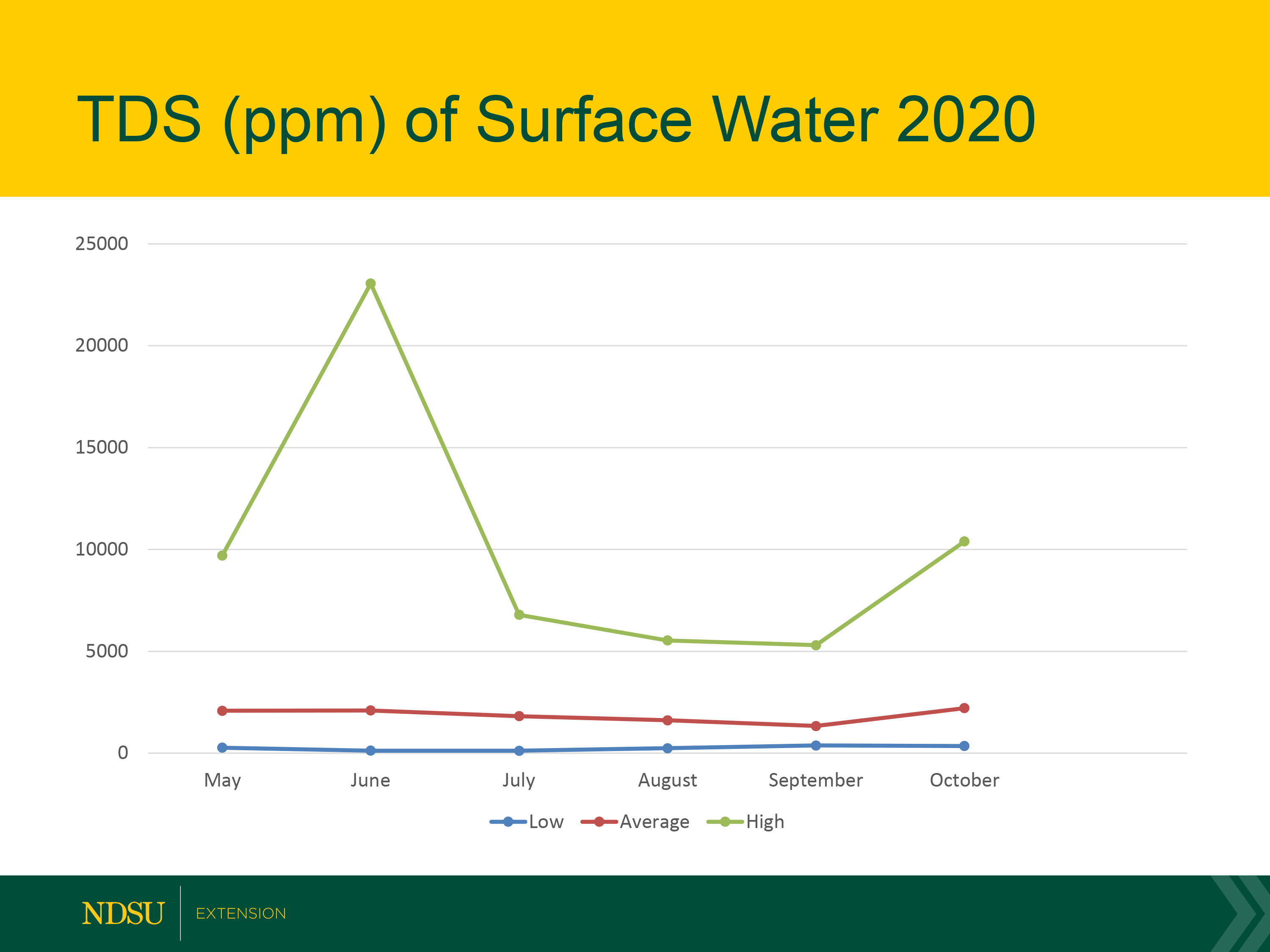Livestock Water Quality Likely to be Impacted by Drought
Access to good-quality water could be a challenge this year.

This shows the total dissolved solids of surface water. (NDSU graphic)
Having access to good-quality water is one of the limiting factors for cattle in most grazing systems.
“During a drought, this becomes an even greater challenge for producers as water sources decrease, creating water shortages and the potential for toxicity,” says Miranda Meehan, North Dakota State University Extension livestock environmental stewardship specialist.
The quality of water has impacts on cattle intake and weight gain. Studies have reported improved gains by as much as 0.24 pound per day in yearlings and 0.33 pound per day in calves drinking good-quality water.
NDSU Extension specialists will discuss water supply and quality during drought as part of the Preparing Your Ranch for Drought webinar series on March 4 at 1 p.m. Central time. To register, go to https://www.ag.ndsu.edu/drought.
When surface waters become low, the mineral component of the water becomes more concentrated because minerals do not evaporate with the water. Of particular concern are increased concentrations of total dissolved solids (TDS) and sulfates, which can be toxic to livestock. For most classes of grazing livestock, the TDS in the water should be less than 5,000 parts per million (ppm).
Sulfate is part of the TDS. The recommended concentration should be less than 500 ppm for calves and less than 1,000 ppm for adult cattle. High levels of sulfate can reduce copper availability in the diet. Elevated levels of sulfates may cause loose stool, whereas very high levels of sulfate can induce central nervous system problems.
Ranchers should monitor TDS and sulfate levels throughout the grazing season because weather and other factors can influence water quality.
“We recommend the use of hand-held TDS meters as a quick method to screen water samples,” Meehan says. “If the screening indicates the TDS is greater than 4,500 ppm, submit a sample to a lab for additional analysis.”
Sulfate test strips are another tool to screen water samples. Both of these tools are affordable and easy to use, according to Meehan.
Drought also increases the risk for cyanobacteria (blue-green algae) blooms that can produce toxins that are harmful to livestock, wildlife and people. Toxicity is dependent on the species consuming the water, the concentration of the toxin or toxins and the amount of water ingested.
The best method for monitoring cyanobacteria is visually. However, this can be difficult due to how rapidly a bloom can develop and ranchers’ ability to check water frequently. One potential solution is to use a camera to monitor water locations.
If a bloom is observed, livestock should be removed immediately and a water sample should be submitted for testing. The sample can be evaluated microscopically for potentially toxic species of cyanobacteria, or the water can be analyzed for several of the toxins at commercial labs at a higher cost.
“As you develop your drought plan, it is critical to include strategies to ensure livestock have adequate, good-quality water,” Meehan says.
Here are some NDSU Extension resources to help ranchers monitor quality:
- “Livestock Water Quality”
(AS1764): http://tinyurl.com/LivestockWater - “Cyanobacteria Poisoning (Blue-green Algae)” (V1136): http://tinyurl.com/NDSUBlue-greenAlgae
- “Livestock Water Testing” Guidelines: tinyurl.com/LivestockWaterTesting
- “Using Electrical Conductivity and Total Dissolved Solid Meters to Field Test Water Quality” (WQ1923): tinyurl.com/Using-EC
- “Livestock Water Sampling” video: https://youtu.be/bQj-c5G-7QQ
- “Using Electrical Conductivity and Total Dissolved Solid Meters to Field Test Water Quality” video: https://youtu.be/jClmfIeZL18
NDSU Agricultural Communication
Source: Miranda Meehan, 701-231-7683, miranda.meehan@ndsu.edu
Editor: Ellen Crawford, 701-231-5391, ellen.crawford@ndsu.edu
